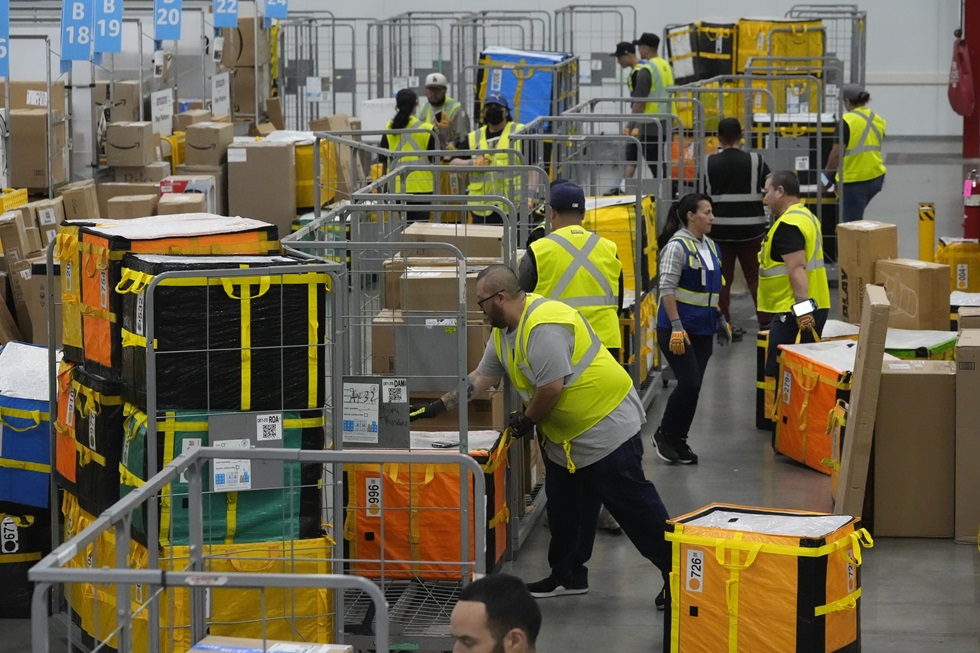
WASHINGTON—Remember Amazon Prime Days, which occurred this year in late July? That’s when the retail and warehouse behemoth racks up billions in revenues—at a high injury cost to its workers: Almost one out of every two, according to internal company documents.
So says Senate Labor Committee Chairman Bernie Sanders, Ind-Vt., releasing an interim report by his panel’s staffers who probed the firm’s own figures, federal Occupational Safety and Health Administration reports, and interviewed workers.
“Amazon warehouses are especially unsafe during Prime Day and the holiday season—and the company knows it,” Sanders declared in releasing his panel’s report last month. It’s part of the committee’s ongoing investigation of the retail monster.
“The incredibly dangerous working conditions at Amazon revealed in this investigation are a perfect example of the type of corporate greed the American people are sick and tired of,” said Sanders.
“Despite making $36 billion in profits last year and providing its CEO,” Andre Jassy, “with over $275 million in compensation over the past three years, Amazon continues to treat its workers as disposable and with complete contempt for their safety and wellbeing.
“That is unacceptable and that has got to change. Amazon must be held accountable for the horrendous working conditions at its warehouses and substantially reduce its injury rates.”
Amazon’s reported injury rates to the federal government are double those for the warehouse industry overall: 6.6 per 100 workers, compared to 3.2 per 100 at non-Amazon warehouses, according to the most-recent federal figures compiled in the AFL-CIO’s Death On The Job report.
Its reported rate during Prime and the holiday shopping season is ten per 100. Its real injury rate is 45 per 100, the Senate panel’s probers discovered.
The Senate staffers reported that in those key periods, Amazon speeds up production lines, doesn’t install or monitor safety devices, deliberately discourages workers from reporting injuries, or sends them off to company-paid doctors who dismiss serious injuries as small problems fixable with, literally, Band-Aids.
And when workers call the Occupational Safety and Health Administration to inspect a warehouse, talk with workers and review records, OSHA finds—as it did in the warehouse outside Lambert Airport in St. Louis—that workers are being treated for the same serious problem ten or 20 or 30 times.
OSHA’s levied thousands of dollars in fines against Amazon. But since the firm garnered $12.7 billion in sales for 375 million products over the two Prime Days alone last year—never mind the holidays—the OSHA fines are a drop in the bucket.
“Critically, although Amazon’s total injury rate includes minor injuries, such as bruises and superficial cuts, it also includes serious injuries, such as torn rotator cuffs and concussions, which the company should have treated as recordable injuries,” and informed OSHA.
“This is due both to Amazon’s practice of failing to refer workers for outside medical care and the company’s troubling history of under-recording injuries as required by federal and state regulations,” the probers reported. The panel staff called that “medical mismanagement.”
Typically, when an Amazon worker gets hurt on the job, the worker is sent to a company in-house doctor in the Amcare clinic. “If their injuries are minor and require only first aid, they are usually treated and sent back to work.
“But if their injuries are more serious and require additional attention, they are often still only given first aid and sent back to work instead of being sent to a doctor.” Not sending them to the doctor also means not reporting injuries to OSHA, either.
Added to that is Amazon’s failure to install basic safety devices in the days just preceding either Amazon Prime or the holiday shopping season.
In one particularly awful example, Amazon installed a new conveyor belt in one warehouse to carry packages weighing up to 50 pounds each. But it didn’t install safety devices to stop the line when items jammed up. So packages fell, injuring workers—including workers who tried to pick them up to meet production quotas.
Interviews with more than 100 workers “not only confirmed the company sets unsustainable productivity requirements and that serious injuries are common, they also told committee staff that Amazon’s busiest periods—Prime Day and the holiday season—are by far the most dangerous.”
“They blew out the warehouse” one worker told committee probers. She said the warehouse usually handles 60,000 packages a day. In Prime Days and holidays, it handles double that number. Amazon’s response: Assembly line speedups, and back-to-back 12-hour shifts with a seven-hour rest period in between.
Maybe the figures should be no shock. Amazon is owned by Jeff Bezos, one of the nation’s three richest people—and he and the firm are known for unflinching hate for unions and for substandard working conditions.
The Washington state Department of Labor and Industries has investigated conditions at Amazon warehouses there. And injury rates were a key talking point for the Amazon Labor Union, then independent, in its campaign to unionize a warehouse just south of Albany, N.Y.
But when Amazon Prime rolls around, as it did on July 26–27 this year, or during the holiday shopping season, injuries at Amazon warehouses get exponentially worse, panel probers found.
And there’s another problem that produces worker injuries, the probers reported. As even Amazon acknowledged in its mandated corporate reports to the Securities and Exchange Commission, when Prime and the holidays roll around, it’s short-staffed.
The firm hired only 51% of workers it needed for the warehouse lines from March-May of last year, before Prime hit. It hired only 71% before the holidays. That forced the other workers to toil even faster, driving up the injury rate. The reason for the lack of workers, the Senate probers say, is simple: Amazon doesn’t pay enough.
“As one of the richest companies in the world, Amazon has the resources to make its warehouses safe for workers. Indeed, its market capitalization recently surpassed $2 trillion. But Amazon repeatedly failed to take meaningful steps to protect its warehouse workers. And the actions the company has taken have paled in comparison to what it could do.
“For example, the company could significantly increase its hourly wages and benefits for workers to aid in recruiting and ensure it has sufficient headcount for peak seasons. The company could also give customers realistic delivery estimates that better balance speed with worker safety. Above all, Amazon could choose to decrease its productivity demands on workers. But Amazon has not done any of this.”
We hope you appreciated this article. At People’s World, we believe news and information should be free and accessible to all, but we need your help. Our journalism is free of corporate influence and paywalls because we are totally reader-supported. Only you, our readers and supporters, make this possible. If you enjoy reading People’s World and the stories we bring you, please support our work by donating or becoming a monthly sustainer today. Thank you!










